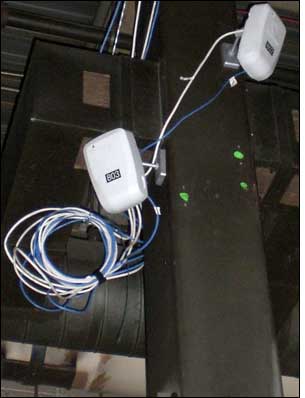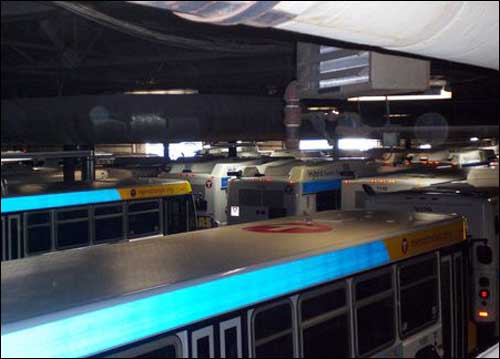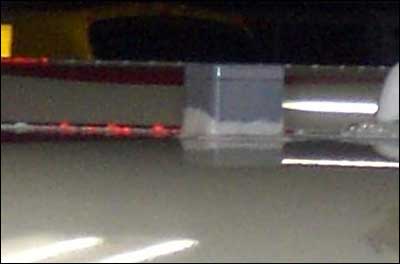Nov 03, 2009Minneapolis and St. Paul's Metro Transit, which provides public transportation for a seven-county area around Minnesota's Twin Cities, has begun employing a real-time locating system (RTLS) RFID application from Ubisense within its five bus depots.
Prior to installing the Ubisense system—which is based on ultra-wideband (UWB) active RFID tags—Metro Transit had deployed an automatic vehicle location (AVL) system utilizing GPS technology to identify the locations of its buses once they leave the depot and are driven along any of 118 bus routes. The AVL system enables Metro Transit to monitor the vehicles' locations in real time, and to track their adherence to each route's schedule.
While the AVL system has allowed dispatchers to know where the buses are on their route, it did not indicate the buses' locations when the vehicles were parked under cement roofs in five garages spread throughout the cities, says Robert Gibbons, the agency's director of customer services.
"The missing link was at the garage," says Gary Nyberg, Metro Transit's manager of technology systems for bus operations. In order for dispatchers to know where buses were, and assign the appropriate vehicle for a particular route, they had to be prepared to walk. "Dispatchers had to take time out to walk the bays with a clipboard," Nyberg says, in order to see the buses for themselves. With that information, they could then determine which vehicles to assign to each route, and when.
To make this process easier, Metro Transit began seeking a wireless solution, and put the order out to bid in 2008, selecting Ubisense in the fall of that year. The system was the vendor's first bus garage management application, and may be the first such garage bus-tracking solution in North America as well, says Russ Chandler, Ubisense Americas' CEO. Since developing the solution for Metro Transit, the firm is now making it available for similar yard-management applications.
At present, the system is approximately 95 percent deployed, Nyberg says, with the installation of a small number of readers in a few remote sections of some garages now underway, and with plans to be fully implemented by the end of this year. The agency operates more than 900 buses, and each now has a Ubisense active UWB tag that transmits its unique ID number at a rate of four times per minute. The tag is attached to the top of the bus, beside the hatch. When a tag's built-in motion sensor detects that the bus is stationary, the tag becomes dormant and ceases transmitting its 6-8.5 GHz signal, thereby extending the life of the tag's internal battery.
Ubisense has installed a series of RFID readers throughout the garages, in such a way that multiple slave units can receive tag transmissions and send that information via a cabled Ethernet connection to a central master node, which then calculates each tag's location based on signal strength from multiple readers, as well as on the angle at which the transmission is received. The system sends that data via another cabled connection to Metro Transit's server, where Ubisense software receives and interprets information from the readers, and then provides a location for each bus on a map of the facility. Most garages have about 60 readers and average approximately 400,000 square feet.
With the new system, Metro Transit's dispatchers need not leave their offices in order to locate buses or assign them out to drivers in the morning. Mechanics use the system to find vehicles quickly when they require servicing, and dispatchers can immediately locate a particular bus within the garage when a passenger calls in regarding a lost item, or if security video footage from a specific vehicle is required. In addition, the system enables Metro Transit to know when each bus leaves a depot, and when it returns, to ensure operator time is being reported properly.
On a computer screen, the Ubisense software displays a floor plan showing the buses' locations and their status—a blue bus icon indicates a particular vehicle originated from a different depot, while a gray icon means a bus has been assigned to a route. A wrench icon signifies the bus requires or is currently receiving repairs. If the user runs the computer mouse over an icon, the system displays details regarding that bus, such as its size and features.
The greatest challenge for Ubisense, Chandler says, was ensuring that readers installed in the ceiling could read the bus tags' RF signals. In the case of lower ceilings, pillars or buses could get in the way of transmission. However, he adds, Ubisense was able to install the readers strategically so that there was no interference.
As the hardware was being installed, Metro Transit also surveyed dispatchers regarding any additional ways in which the system could benefit them, and thus learned that there would also be a benefit to tracking some vehicles parked outside the garage. In this case, Nyberg says, installing additional Ubisense readers would have required added labor and the running of conduit, so instead, the agency chose to use the AVL data in outdoor locations, and to integrate the AVL system into the Ubisense software, thereby allowing dispatchers to go into the Ubisense system and view a list of vehicles parked in outdoor locations.
"It's an efficiency tool for us," Gibbons states, and dispatcher responsibilities are now being reevaluated, as the dispatchers have more time available during their days. "Our guiding principle is valuing innovation and creativity," he says, "and we look for opportunities to improve our services."




